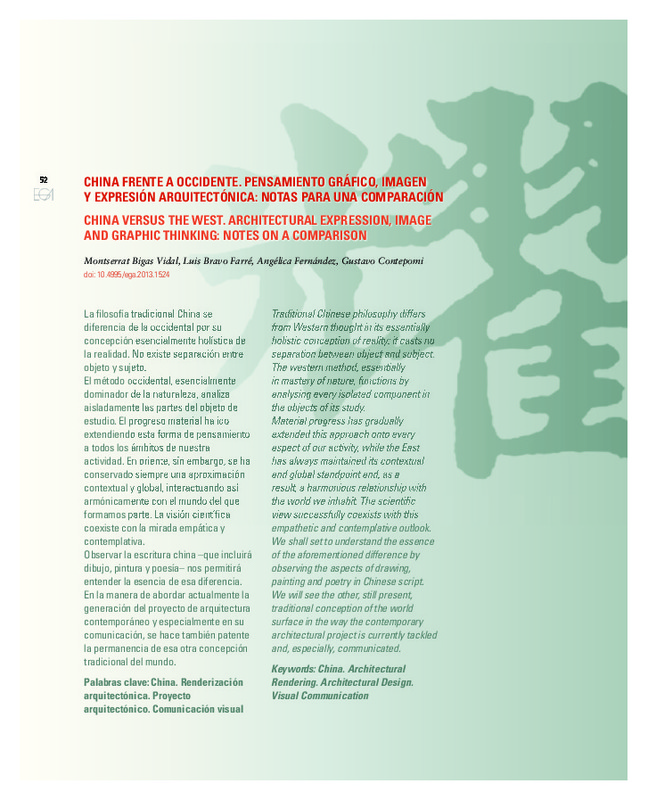JavaScript is disabled for your browser. Some features of this site may not work without it.
Buscar en RiuNet
Listar
Mi cuenta
Estadísticas
Ayuda RiuNet
Admin. UPV
China frente a occidente. Pensamiento gráfico, imagen y expresión arquitectónica: notas para una comparación
Mostrar el registro sencillo del ítem
Ficheros en el ítem
| dc.contributor.author | Bigas Vidal, Montserrat
|
es_ES |
| dc.contributor.author | Bravo, Luis
|
es_ES |
| dc.contributor.author | Fernández, Angélica
|
es_ES |
| dc.contributor.author | Contepomi, Gustavo
|
es_ES |
| dc.date.accessioned | 2013-09-25T07:39:17Z | |
| dc.date.issued | 2013 | |
| dc.identifier.issn | 1133-6137 | |
| dc.identifier.uri | http://hdl.handle.net/10251/32333 | |
| dc.description.abstract | [EN] Traditional Chinese philosophy differs from Western thought in its essentially holistic conception of reality: it casts no separation between object and subject. The western method, essentially in mastery of nature, functions by analysing every isolated component in the objects of its study. Material progress has gradually extended this approach onto every aspect of our activity, while the East has always maintained its contextual and global standpoint and, as a result, a harmonious relationship with the world we inhabit. The scientific view successfully coexists with this empathetic and contemplative outlook. We shall set to understand the essence of the aforementioned difference by observing the aspects of drawing, painting and poetry in Chinese script. We will see the other, still present, traditional conception of the world surface in the way the contemporary architectural project is currently tackled and, especially, communicated. | es_ES |
| dc.description.abstract | [ES] La filosofía tradicional China se diferencia de la occidental por su concepción esencialmente holística de la realidad. No existe separación entre objeto y sujeto.El método occidental, esencialmente dominador de la naturaleza, analiza aisladamente las partes del objeto de estudio. El progreso material ha ido extendiendo esta forma de pensamiento a todos los ámbitos de nuestra actividad. En oriente, sin embargo, se ha conservado siempre una aproximación contextual y global, interactuando así armónicamente con el mundo del que formamos parte. La visión científica coexiste con la mirada empática y contemplativa.Observar la escritura china ¿que incluirá dibujo, pintura y poesía- nos permitirá entender la esencia de esa diferencia.En la manera de abordar actualmente la generación del proyecto de arquitectura contemporáneo y especialmente en su comunicación, se hace también patente la permanencia de esa otra concepción tradicional del mundo. | es_ES |
| dc.language | Español | es_ES |
| dc.language | Inglés | |
| dc.publisher | Editorial Universitat Politècnica de València | |
| dc.relation.ispartof | EGA. Revista de Expresión Gráfica Arquitectónica | |
| dc.rights | Reserva de todos los derechos | es_ES |
| dc.subject | Architectural Rendering | es_ES |
| dc.subject | Architectural Design | es_ES |
| dc.subject | Visual Communication | es_ES |
| dc.subject | China | es_ES |
| dc.subject | Renderización arquitectónica | es_ES |
| dc.subject | Proyecto arquitectónico | es_ES |
| dc.subject | Comunicación visual | es_ES |
| dc.title | China frente a occidente. Pensamiento gráfico, imagen y expresión arquitectónica: notas para una comparación | es_ES |
| dc.title.alternative | China versus the west. Arqhitectural expression image and graphic thinking: notes on a comparison | es_ES |
| dc.type | Artículo | es_ES |
| dc.date.updated | 2013-09-24T09:44:36Z | |
| dc.identifier.doi | 10.4995/ega.2013.1524 | |
| dc.rights.accessRights | Abierto | es_ES |
| dc.description.bibliographicCitation | Bigas Vidal, M.; Bravo, L.; Fernández, A.; Contepomi, G. (2013). China frente a occidente. Pensamiento gráfico, imagen y expresión arquitectónica: notas para una comparación. EGA. Revista de Expresión Gráfica Arquitectónica. 18(21):52-61. https://doi.org/10.4995/ega.2013.1524 | es_ES |
| dc.description.accrualMethod | SWORD | es_ES |
| dc.relation.publisherversion | https://doi.org/10.4995/ega.2013.1524 | es_ES |
| dc.description.upvformatpinicio | 52 | es_ES |
| dc.description.upvformatpfin | 61 | es_ES |
| dc.description.volume | 18 | |
| dc.description.issue | 21 | |
| dc.identifier.eissn | 2254-6103 | |
| dc.description.references | – Ku, H.M., 2007. The Spirit of the Chinese People. Beijing: Foreign Language Teaching and Research Press. | es_ES |
| dc.description.references | – Gai, W., 1978.The Mustard Seed Garden Manual of Painting.Princeton: Princeton Bollingen. | es_ES |
| dc.description.references | – Fenollosa, E., Pound, E., 1977. El carácter de la escritura china como medio poético. Madrid: Visor. | es_ES |
| dc.description.references | – Verdier, F., 2003. Passagère du silence. Paris: Albin Michel. | es_ES |
| dc.description.references | – Huazhong University of Science and Technology, 2006. Architecture and Rendering Yearbook of China. Wuhan. | es_ES |
| dc.description.references | – Huazhong University of Science and Technology, 2011. Architectural Rendering X File. Wuhan. | es_ES |








